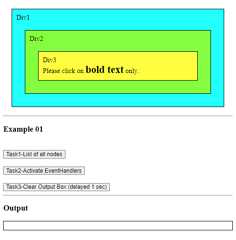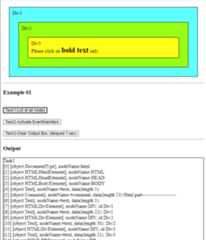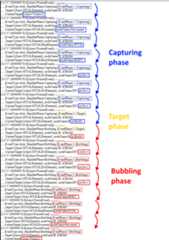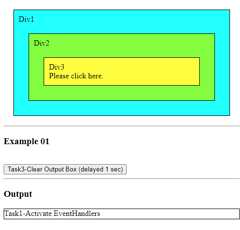
Tutorial on “Events Bubbling” in JavaScript language
Abstract: This is tutorial text on “events bubbling” in JavaScript. Some theory is explained, and several JavaScript examples are shown.
1 Introduction
The purpose of this article is to provide an illustrative example of the “bubbling and capturing of events” in browser DOM. This is not meant to be a complete tutorial, but rather a “proof of concept” of how events propagate in DOM.
2 Theoretical background
Every DOM Node can generate an event. An event is a signal that something happened.
To react to an event, we need to assign a Node anevent handler. There are 3 ways to assign a handler:
- Html attribute usage. For example: onclick=”myhandler(e)”;
- DOM property usage. For example: element.onclick=myhandler;
- Javascript method. For example: element.addEventListener(e, myhandler, phase);
The existence of the method “addEventListener” is coming from the fact that every Node in DOM inherits from EventTarget [2] which acts as a root abstract class. So, every Node can receive events and react on them via an event handler.
Most events in DOM propagate. Typically there are 3 phases of event propagation:
- Capturing phase. Propagation from window object toward specific target event
- Target phase. The event has reached its target.
- Bubbling phase. Propagation from the target toward the window object
Anevent object is being thrown when an event happens. It contains properties describing that event. Two properties are very interesting to us:
- event.currentTarget – object that handled the event (for example, some parent of an element that was actually clicked, that got that event by the act of bubbling)
- event.target – target element that initiated the event ( for example, the element on which it was actually clicked)
3 Example01 -Simple event propagation demo
3.1 Going over all Nodes
First, we want to create a list of all Event recipients of interest. That will include all Nodes in our DOM plus “document” and “window” objects. Here is the code for that:
functiongetDescendants(node,myArray=null){//note that we are looking for all Nodes, not just Elements//going recursively into deptvari;myArray=myArray||[];for(i=0;i<node.childNodes.length;i++){myArray.push(node.childNodes[i])getDescendants(node.childNodes[i],myArray);}returnmyArray;}functionCreateListOfEventRecipients(){letresult;//get all Nodes inside documentresult=getDescendants(document);//add Document objectresult.push(window.document);//add Window objectresult.push(window);returnresult;}3.2 Logging Events
Next, we want to nicely log events in our event-handler function. Here is the code for that:
functionEventDescription(e,handlerPhase){//function to log info from event object//here are properties, that are important//->handlerPhase -> we log info from which handler this event is coming// from, is this from bubbling of capturing handler//->e.toString() -> class of event object//->e.type -> type of even, for example "click"//->e.timeStamp -> timestamp of event in milliseconds,// counted from load of the page//->e.target -> real target (object) of event, for example// real object that was clicked on//->e.currentTarget -> current target (object) that is throwing// this event, since event got here by either// bubbling of capturing propagation//->e.eventPhase -> real phase of event, regardless of handler that// created event handler, can be 1-capturing,// 2-target, 3-bubbling phase/* Sample execution: 6600.900000095367[object PointerEvent]----------- ......EventType:click..HandlerPhase:Capturing..EventPhase:1 (Capturing) ......Target:[object HTMLElement], nodeName:B, id:Bold4 ......CurrentTarget:[object HTMLDivElement], nodeName:DIV, id:Div1 */constdots="......";letresult;if(e!==undefined&&e!==null){leteventObject=e.toString();leteventType=(e.type)?(e.type.toString()):undefined;leteventTimestamp=(e.timeStamp)?(e.timeStamp.toString()):undefined;leteventTarget=(e.target)?ObjectDescription(e.target):undefined;leteventCurrentTarget=(e.currentTarget)?ObjectDescription(e.currentTarget):undefined;leteventPhase=(e.eventPhase)?PhaseDescription(e.eventPhase):undefined;result="";result+=(eventTimestamp)?eventTimestamp:"";result+=(eventObject)?eventObject:"";result+="-----------<br>";result+=dots;result+=(eventType)?("EventType:"+eventType):"";result+=(handlerPhase)?("..HandlerPhase:"+handlerPhase):"";result+=(eventPhase)?("..EventPhase:"+eventPhase):"";result+="<br>";result+=(eventTarget)?(dots+"Target:"+eventTarget+"<br>"):"";result+=(eventCurrentTarget)?(dots+"CurrentTarget:"+eventCurrentTarget+"<br>"):"";}returnresult;}3.3 Full Example01 code
Here is the full Example01 code, since most people like code that they can copy-paste.
<!DOCTYPEhtml><html><body><!--Htmlpart----------------------------------------------><divid="Div1"style="border: 1px solid; padding:10px; margin:20px; background-color:aqua;">Div1<divid="Div2"style="border: 1px solid; padding:10px; margin:20px;background-color:chartreuse">Div2<divid="Div3"style="border: 1px solid; padding:10px; margin:20px; background-color:yellow;">Div3<br/>Pleaseclickon<bid="Bold4"style="font-size:x-large;">boldtext</b> only.</div></div></div><hr/><h3>Example01</h3><br/><buttononclick="task1()">Task1-Listofallnodes</button><br /><br/><buttononclick="task2()">Task2-ActivateEventHandlers</button><br /><br/><buttononclick="task3()">Task3-ClearOutputBox(delayed1sec)</button><br /><hr/><h3>Output</h3><divid="OutputBox"style="border: 1px solid; min-height:20px"></div><!--JavaScriptpart----------------------------------------------><script>functionOutputBoxClear(){document.getElementById("OutputBox").innerHTML="";}functionOutputBoxWriteLine(textLine){document.getElementById("OutputBox").innerHTML+=textLine+"<br/>";}functionOutputBoxWrite(textLine){document.getElementById("OutputBox").innerHTML+=textLine;}functionObjectDescription(oo){//expecting Node or Window or Document//logging some basic info to be able to//identify which object is that in the DOM treeletresult;if(oo!=null){result="";result+=oo.toString();if(oo.nodeName!==undefined){result+=", nodeName:"+oo.nodeName;}if(oo.id!==undefined&&oo.id!==null&&oo.id.trim().length!==0){result+=", id:"+oo.id;}if(oo.data!==undefined){letmyData=oo.data;letlength=myData.length;if(length>30){myData=myData.substring(0,30);}result+=`, data(length${length}):`+myData;}}returnresult;}functionPhaseDescription(phase){//some text to explain phase numbersletresult;if(phase!==undefined&&phase!==null){switch(phase){case1:result="1 (Capturing)";break;case2:result="2 (Target)";break;case3:result="3 (Bubbling)";break;default:result=phase;break;}}returnresult;}functionEventDescription(e,handlerPhase){//function to log info from event object//here are properties, that are important//->handlerPhase -> we log info from which handler this event is coming// from, is this from bubbling of capturing handler//->e.toString() -> class of event object//->e.type -> type of even, for example "click"//->e.timeStamp -> timestamp of event in milliseconds,// counted from load of the page//->e.target -> real target (object) of event, for example// real object that was clicked on//->e.currentTarget -> current target (object) that is throwing// this event, since event got here by either// bubbling of capturing propagation//->e.eventPhase -> real phase of event, regardless of handler that// created event handler, can be 1-capturing,// 2-target, 3-bubbling phase/* Sample execution: 6600.900000095367[object PointerEvent]----------- ......EventType:click..HandlerPhase:Capturing..EventPhase:1 (Capturing) ......Target:[object HTMLElement], nodeName:B, id:Bold4 ......CurrentTarget:[object HTMLDivElement], nodeName:DIV, id:Div1 */constdots="......";letresult;if(e!==undefined&&e!==null){leteventObject=e.toString();leteventType=(e.type)?(e.type.toString()):undefined;leteventTimestamp=(e.timeStamp)?(e.timeStamp.toString()):undefined;leteventTarget=(e.target)?ObjectDescription(e.target):undefined;leteventCurrentTarget=(e.currentTarget)?ObjectDescription(e.currentTarget):undefined;leteventPhase=(e.eventPhase)?PhaseDescription(e.eventPhase):undefined;result="";result+=(eventTimestamp)?eventTimestamp:"";result+=(eventObject)?eventObject:"";result+="-----------<br>";result+=dots;result+=(eventType)?("EventType:"+eventType):"";result+=(handlerPhase)?("..HandlerPhase:"+handlerPhase):"";result+=(eventPhase)?("..EventPhase:"+eventPhase):"";result+="<br>";result+=(eventTarget)?(dots+"Target:"+eventTarget+"<br>"):"";result+=(eventCurrentTarget)?(dots+"CurrentTarget:"+eventCurrentTarget+"<br>"):"";}returnresult;}functiongetDescendants(node,myArray=null){//note that we are looking for all Nodes, not just Elements//going recursively into deptvari;myArray=myArray||[];for(i=0;i<node.childNodes.length;i++){myArray.push(node.childNodes[i])getDescendants(node.childNodes[i],myArray);}returnmyArray;}functionCreateListOfEventRecipients(){letresult;//get all Nodes inside documentresult=getDescendants(document);//add Document objectresult.push(window.document);//add Window objectresult.push(window);returnresult;}functionMyEventHandler(event,handlerPhase){OutputBoxWrite(EventDescription(event,handlerPhase));}functionBubblingEventHandler(event){MyEventHandler(event,"Bubbling");}functionCapturingEventHandler(event){MyEventHandler(event,"Capturing");}window.onerror=function(message,url,line,col,error){OutputBoxWriteLine(`Error:${message}\n At${line}:${col} of${url}`);};functiontask1(){//we need to delay for 1 second aaa//to avoid capturing click on button itselfsetTimeout(task1_worker,1000);}functiontask1_worker(){//show all Nodes plus Window plus Document//they all receive eventsOutputBoxClear();OutputBoxWriteLine("Task1");letarrayOfEventRecipientCandidates=CreateListOfEventRecipients();for(leti=0;i<arrayOfEventRecipientCandidates.length;++i){letdescription=ObjectDescription(arrayOfEventRecipientCandidates[i]);OutputBoxWriteLine(`[${i}]${description}`);}}functiontask2(){OutputBoxClear();OutputBoxWriteLine("Task2");//we need to delay for 1 second creation of EventsHandlers//to avoid capturing click on button Task2 itselfsetTimeout(task2_worker,1000);}functiontask2_worker(){//create list of all Event Recipients//and assigning Events HandlersletarrayOfEventRecipientCandidates=CreateListOfEventRecipients();for(leti=0;i<arrayOfEventRecipientCandidates.length;++i){//we check that each member of list can receive eventsif("addEventListener"inarrayOfEventRecipientCandidates[i]){//adding Event Handlers for Bubbling phase//actually, this will be handler for bubbling and target phasearrayOfEventRecipientCandidates[i].addEventListener("click",BubblingEventHandler);//adding Event Handlers for Capturing phase//actually, this will be handler for capturing and target phasearrayOfEventRecipientCandidates[i].addEventListener("click",CapturingEventHandler,true);}else{//here printout if any object from the list can not receive Eventsletdescription="Object does not have addEventListener:"+ObjectDescription(arrayOfEventRecipientCandidates[i]);OutputBoxWriteLine(`[${i}]${description}`);}}}functiontask3(){//we need to delay for 1 second aaa//to avoid capturing click on button Task3 itselfsetTimeout(OutputBoxClear,1000);}</script></body><!--Output--></html>3.4 Application screenshot
Here is what the application looks like:
3.5 Execution – finding all Event-Targets
First, we will show all Event Targets that our methods find. That includes all Nodes plus “document’ and “window” objects. There are around 60 objects on that list. Note that it includes ALL Nodes, including text and comment nodes.
3.6 Execution – activating Event-Handlers
Then we activate Event-Handlers for all objects in the list.
3.7 Execution – Click Event
Now we do our click. Here is a log of events from the application:
3.8 Comments
For those who like DOM tree diagrams, here is a diagram of what happened in the application.
• Please note that the above diagram does not include “document” and “window” objects that, as can be seen from the log, are also recipients of the click event
• Please note that although we actually clicked text Node“#text-6”, that Node did not receive the event, but the Element that contains it“B Id:Bold4” did receive the click event.
4 Example02
The reason I created this example is because I saw claims on the Internet that in the Target phase, events and not always run in Capturing-Bubbling order, but in order they are defined in the code. I find those claims untrue, at least for this version of Chrome I used for testing.
4.2 Code
I will not put here whole code, since is similar to the previous example. Here are just key parts:
functiontask1(){OutputBoxClear();OutputBoxWriteLine("Task1-Activate EventHandlers");//Div1 event handlersletdiv1=document.getElementById("Div1");div1.addEventListener("click",(e)=>MyEventHandler(e,"Bubbling"));div1.addEventListener("click",(e)=>MyEventHandler(e,"Capturing"),true);//Div2 event handlersletdiv2=document.getElementById("Div2");div2.addEventListener("click",(e)=>MyEventHandler(e,"Bubbling"));div2.addEventListener("click",(e)=>MyEventHandler(e,"Capturing"),true);//Div3 event handlers//we deliberately mix defining order of bubbling and capturing events//to see order when events are fired (**)letdiv3=document.getElementById("Div3");//actually, this will be handler for bubbling and target phasediv3.addEventListener("click",(e)=>MyEventHandler(e,"Bubbling"));//actually, this will be handler for capturing and target phasediv3.addEventListener("click",(e)=>MyEventHandler(e,"Capturing"),true);//actually, this will be handler for bubbling and target phasediv3.addEventListener("click",(e)=>MyEventHandler(e,"Bubbling2"));//actually, this will be handler for capturing and target phasediv3.addEventListener("click",(e)=>MyEventHandler(e,"Capturing2"),true);}Please note that in (**) we interleaved definition of Capturing and Bubbling event handlers for the same element.
4.3 Screenshot
Here is the application screenshot.
4.4 Execution – Our Click
Now we do our click. Here is a log that is produced:
As far as I see (on this version of Chrome), in the Target phase, all events are run in order of Event-Handlers Capturing first, then Bubbling. Handlers are not run in order as defined in (**).
If you look at the Target Phase (yellow), you will see the order of events “Capturing”, “Capturing2”, “Bubbling”, “Bubbling2” in this execution. What some people on the internet claimed is that the order will be the same as in definition (**), something like “Capturing”, “Bubbling”, “Capturing2”, “Bubbling2”. But, this experiment of mine disproves that claim, at least for this version of Chrome.
5 Conclusion
In this article, we provided a simple “proof-of-concept” application that shows how event propagation in DOM works.
6 Code
https://github.com/MarkPelf/JavaScriptEventsBubblingIllustrated
7 References
Top comments(0)
For further actions, you may consider blocking this person and/orreporting abuse












